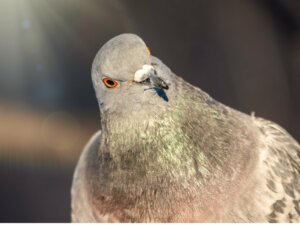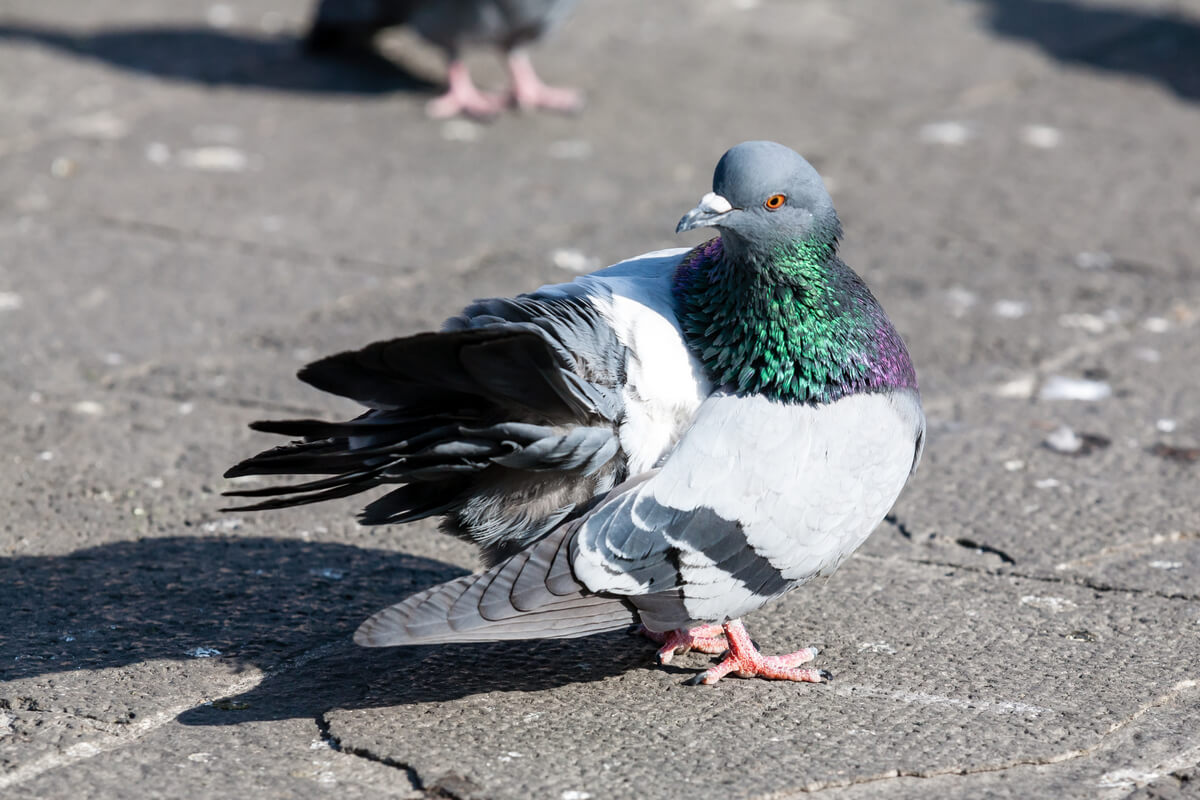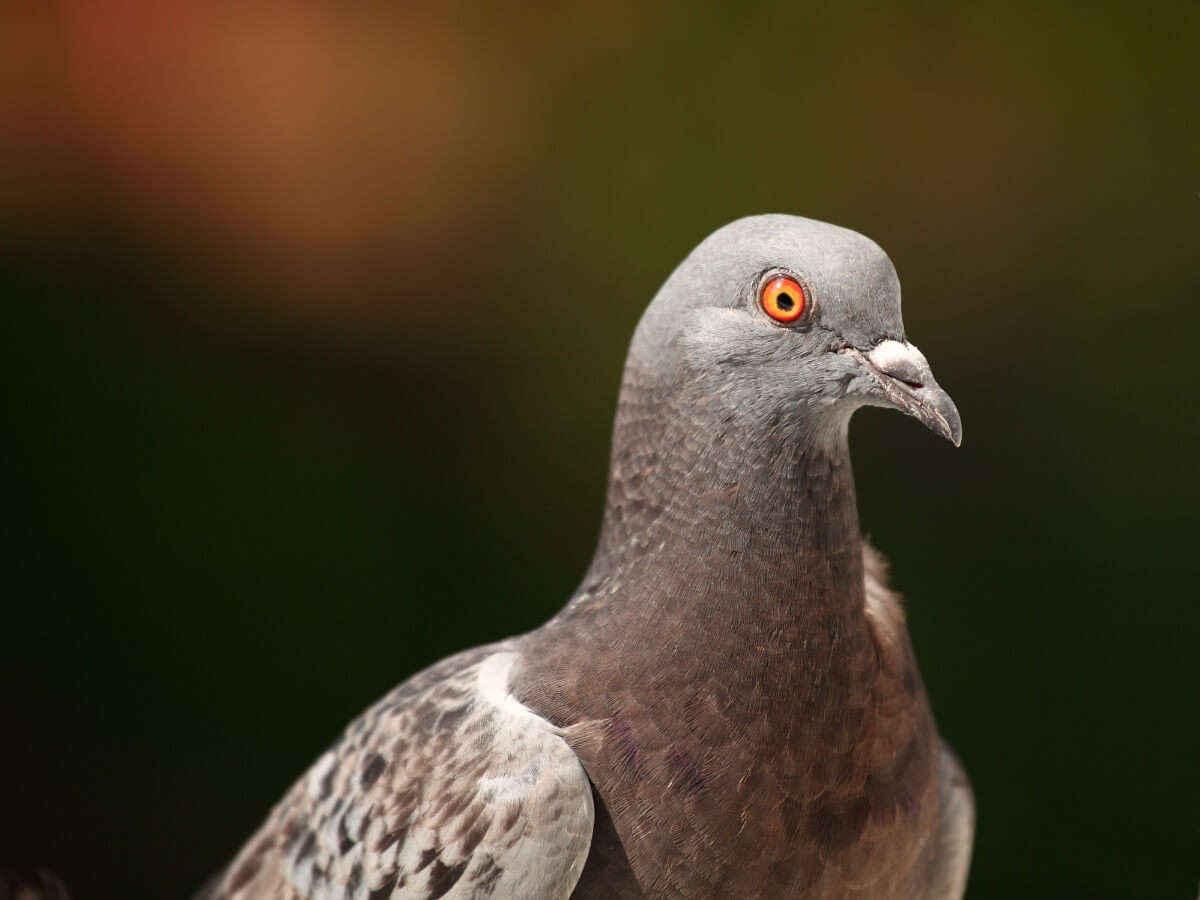All About Pigeon Behavior

Pigeons (from the Columbidae family) group together a series of birds, such as the Gourinae and turtle doves, and form a total of 308 species. They have been part of human life since ancient times. From religious symbols to scientific studies of pigeon behavior, these winged animals have accompanied us since the dawn of culture.
Despite seeing them every day in urban and rural environments, you wouldn’t realize their great intelligence and learning capacity unless you examined them carefully. That’s why we’ve written this article for you, just so you can get to know them a little better.
Social behavior of pigeons
Pigeons, as you may have observed, move in flocks comprising several individuals. Within each group, a well-structured hierarchy is established through pecking, but we can also observe horizontal relationships between members. In fact, it has been observed that the two forms of organization – hierarchical and egalitarian – can be alternated according to needs.
Agonistic behavior is also observed among pigeons, especially during feeding. If a dominant bird sees another trying to take its food, it will defend itself. It may do it by swelling its neck feathers – as a warning, or it may get involved in a violent fight, in which they’ll grab each other’s beaks and hit each other with their wings.
Territoriality is also a common behavior, especially among males. This is known as “perch rights”. The territory is marked as regards the branches each pigeon will rest on at night.

Pigeon behavior in reproduction
Pigeon behavior as regards reproduction is mainly monogamous, as sometimes the same members of a couple are found at different periods of reproduction. Several phases are observed in the formation of a bond:
- Courtship: The male performs a mating dance that consists of inflating its feathers, dragging its tail, and moving in circles around the female. It emits a specific vocalization for this ritual, similar to a lullaby.
- Acceptance: If the female accepts him as a mate, she will approach the male and raise her tail while lowering her head. This courtship and copulation process can occur many times throughout a week.
- Nesting and incubation: Parental care is equitable, as both males and females incubate and care for the chicks when they hatch.
The flight of the pigeons
Hierarchy – and egalitarian organization – are also reflected in the way these birds fly. Thanks to their incredible orientation ability, they’re able to communicate with each other and establish optimal routes to find resources and avoid predators, for example.
When noticing any disturbance during the flight, the first pigeons to detect it will warn the others. When this alert reaches the leaders of the flock, they’ll take a new course and the others will follow. In this way, they’re able to improvise strategies that help them survive in hostile environments.
Pigeon training and intelligence
Although their enormous capacity for learning was recognized in ancient times (you only have to look at homing pigeons) these birds have also been a recurring animal model in studies of behavior and learning. Because of their good eyesight and ability to see colors, most experiments are based on color-coded object associations.
In this type of experiment, it was found that pigeons aren’t only capable of discriminating a multitude of items, but they can even teach it to other specimens. This was studied with really complex stimuli: works of art by Van Gogh and Chagall, among others.
Furthermore, pigeons are capable of recognizing themselves in the mirror: they’re self-aware.
Problem-solving isn’t lost on these birds either. In experiments in which they were prevented from entering food sources, pigeons learned to remove obstacles to reach them. Moreover, by changing the shape and color of the obstacles, they adapted their behavior to solve the new aspects of the test.

Birds that deserve respect
Pigeons often suffer the widespread stigma of being dirty and disease-carrying birds. Although it’s true that it’s common to see them parasitized or sick in urban environments, this is due to an unhealthy environment, rather than their own nature.
However, if we put our prejudices aside, what remains is their curious gaze and the unusual iridescence of its feathers. These birds deserve respect as they’re much more intelligent than they’re given credit for.
Pigeons (from the Columbidae family) group together a series of birds, such as the Gourinae and turtle doves, and form a total of 308 species. They have been part of human life since ancient times. From religious symbols to scientific studies of pigeon behavior, these winged animals have accompanied us since the dawn of culture.
Despite seeing them every day in urban and rural environments, you wouldn’t realize their great intelligence and learning capacity unless you examined them carefully. That’s why we’ve written this article for you, just so you can get to know them a little better.
Social behavior of pigeons
Pigeons, as you may have observed, move in flocks comprising several individuals. Within each group, a well-structured hierarchy is established through pecking, but we can also observe horizontal relationships between members. In fact, it has been observed that the two forms of organization – hierarchical and egalitarian – can be alternated according to needs.
Agonistic behavior is also observed among pigeons, especially during feeding. If a dominant bird sees another trying to take its food, it will defend itself. It may do it by swelling its neck feathers – as a warning, or it may get involved in a violent fight, in which they’ll grab each other’s beaks and hit each other with their wings.
Territoriality is also a common behavior, especially among males. This is known as “perch rights”. The territory is marked as regards the branches each pigeon will rest on at night.

Pigeon behavior in reproduction
Pigeon behavior as regards reproduction is mainly monogamous, as sometimes the same members of a couple are found at different periods of reproduction. Several phases are observed in the formation of a bond:
- Courtship: The male performs a mating dance that consists of inflating its feathers, dragging its tail, and moving in circles around the female. It emits a specific vocalization for this ritual, similar to a lullaby.
- Acceptance: If the female accepts him as a mate, she will approach the male and raise her tail while lowering her head. This courtship and copulation process can occur many times throughout a week.
- Nesting and incubation: Parental care is equitable, as both males and females incubate and care for the chicks when they hatch.
The flight of the pigeons
Hierarchy – and egalitarian organization – are also reflected in the way these birds fly. Thanks to their incredible orientation ability, they’re able to communicate with each other and establish optimal routes to find resources and avoid predators, for example.
When noticing any disturbance during the flight, the first pigeons to detect it will warn the others. When this alert reaches the leaders of the flock, they’ll take a new course and the others will follow. In this way, they’re able to improvise strategies that help them survive in hostile environments.
Pigeon training and intelligence
Although their enormous capacity for learning was recognized in ancient times (you only have to look at homing pigeons) these birds have also been a recurring animal model in studies of behavior and learning. Because of their good eyesight and ability to see colors, most experiments are based on color-coded object associations.
In this type of experiment, it was found that pigeons aren’t only capable of discriminating a multitude of items, but they can even teach it to other specimens. This was studied with really complex stimuli: works of art by Van Gogh and Chagall, among others.
Furthermore, pigeons are capable of recognizing themselves in the mirror: they’re self-aware.
Problem-solving isn’t lost on these birds either. In experiments in which they were prevented from entering food sources, pigeons learned to remove obstacles to reach them. Moreover, by changing the shape and color of the obstacles, they adapted their behavior to solve the new aspects of the test.

Birds that deserve respect
Pigeons often suffer the widespread stigma of being dirty and disease-carrying birds. Although it’s true that it’s common to see them parasitized or sick in urban environments, this is due to an unhealthy environment, rather than their own nature.
However, if we put our prejudices aside, what remains is their curious gaze and the unusual iridescence of its feathers. These birds deserve respect as they’re much more intelligent than they’re given credit for.
All cited sources were thoroughly reviewed by our team to ensure their quality, reliability, currency, and validity. The bibliography of this article was considered reliable and of academic or scientific accuracy.
- Watanabe, S. (2001). Van Gogh, Chagall and pigeons: picture discrimination in pigeons and humans. Animal Cognition, 4(3-4), 147-151.
- Cook, R. G., & Fowler, C. (2014). “Insight” in pigeons: absence of means–end processing in displacement tests. Animal cognition, 17(2), 207-220.
- Columba livia (common pigeon). (s. f.). Animal Diversity Web. Recuperado 26 de julio de 2021, de https://animaldiversity.org/accounts/Columba_livia/
- Pettit, B., Flack, A., Freeman, R., Guilford, T., & Biro, D. (2013). Not just passengers: pigeons, Columba livia, can learn homing routes while flying with a more experienced conspecific. Proceedings of the Royal Society B: Biological Sciences, 280(1750), 20122160.
- Williams, C. D., & Biewener, A. A. (2015). Pigeons trade efficiency for stability in response to level of challenge during confined flight. Proceedings of the National Academy of Sciences, 112(11), 3392-3396.
This text is provided for informational purposes only and does not replace consultation with a professional. If in doubt, consult your specialist.








